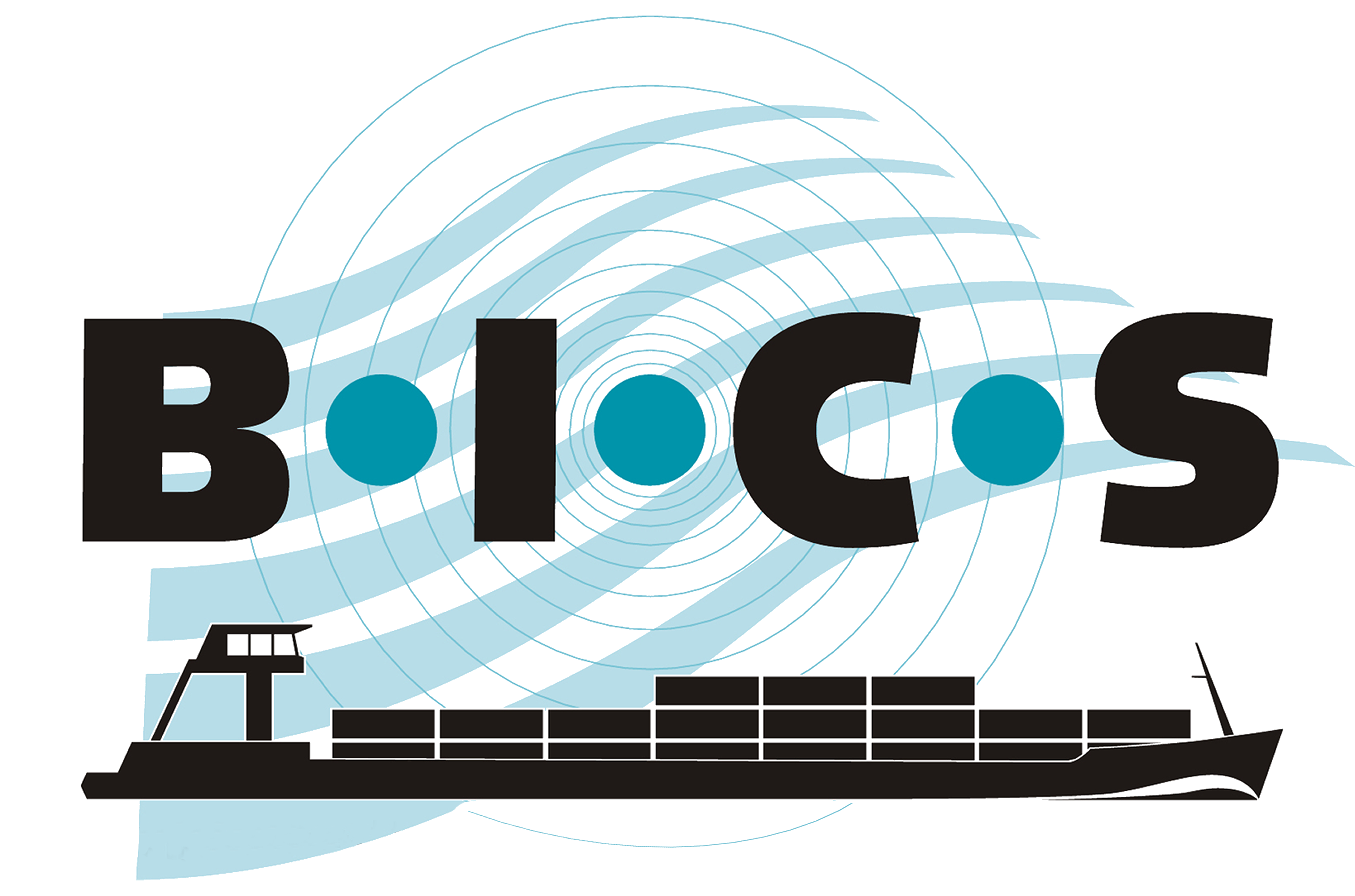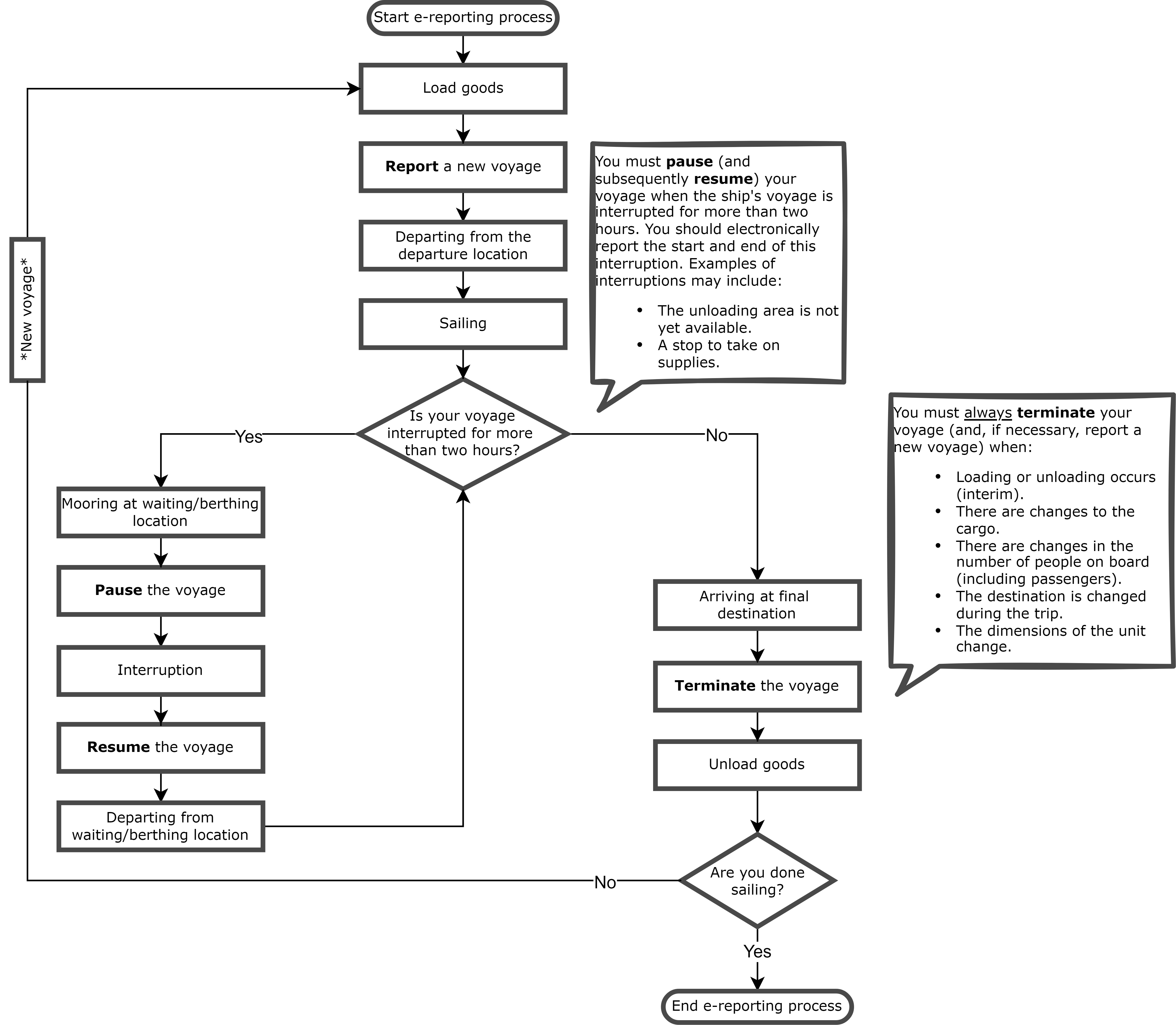![]() This manual contains instructions for skippers who must comply with the electronic reporting obligation and wish to report to the waterway authorities using BICS.
This manual contains instructions for skippers who must comply with the electronic reporting obligation and wish to report to the waterway authorities using BICS.
1. The Electronic Reporting Obligation
1.1 Who is obligated to report electronically?
Since December 1, 2021, data (which corresponds with the reporting requirements specified in RPR Article 12.01) must mostly be reported electronically. The electronic reporting obligation, which previously applied only to convoys and vessels carrying containers, as well as vessels with fixed tanks on board, has now been extended to the following types of vessels:
- Vessels that fall under Article 12.01, first paragraph, part a of the RPR that carry goods to which the ADN applies;
- Vessels that fall under Article 12.01, first paragraph, part d of the RPR with a length exceeding 110 meters;
- Hotel vessels that fall under Article 12.01, first paragraph, part e of the RPR;
- Sea-going vessels that fall under Article 12.01, first paragraph, part f of the RPR;
- Vessels that fall under Article 12.01, first paragraph, part g of the RPR that have an LNG system on board;
- Special transports as referred to in Article 1.21, as stated in Article 12.01, first paragraph, part h of the RPR.
Note: All of the above-mentioned vessels in bold (the so-called 'target vessels') must report electronically to the first traffic post or waterway authority on the route before departure.
1.2 What data must be reported?
To comply with the electronic reporting requirement, the following data must be reported to the waterway authorities. The BICS software provides an easy and clear way to compile and electronically report the following voyage and cargo data to a waterway authority, in accordance with the legal reporting requirement:
- Vessel name; and for convoys, the name of all vessels in the convoy;
- Unique European vessel identification number (ENI number), IMO number for sea-going vessels; of the vessel and for convoys of all vessels in the convoy;
- Type of vessel or convoy; and for convoys, the type of vessel for all vessels as per the messages mentioned in the first paragraph;
- Carrying capacity; of the vessel and for convoys of all vessels in the convoy;
- Length and width of the vessel; and for convoys, the length and width of the convoy and of all vessels in the convoy;
- Presence of an LNG installation on board;
- For a vessel carrying goods to which the ADN applies:
- The UN numbers or the numbers of the dangerous goods;
- The proper shipping name of the dangerous goods;
- The class, classification code, and if applicable, the packing group of the dangerous goods;
- The total quantity of dangerous goods to which this data relates;
- The number of blue lights/cones;
- For a vessel carrying goods to which the ADN does not apply and that are not transported in containers: type and quantity of cargo;
- Number of containers on board by size and loading status (loaded or unloaded) and the respective location of containers according to the stowage plan and container type;
- Container number of containers carrying dangerous goods;
- Total number of persons on board, and where applicable, the number of passengers;
- Position and sailing direction;
- Draught, if requested by the competent authority;
- Route, indicating the departure and destination ports;
- Port where cargo is loaded;
- Port where cargo is unloaded.
1.3 What is the purpose of electronic reports?
Electronic reports are used to support various RIS services for the following purposes:
- Traffic guidance (strategic traffic information, lock and bridge management);
- Incident management;
- Transport management (port and terminal management, cargo and fleet management);
- Statistics;
- Charges for the use of waterway infrastructure;
- Border control;
- Customs services.
2. The Reporting Procedure
2.1 What is considered a 'voyage' in BICS?
A "voyage" is when the ship sails from the port of departure (starting port) to the next port of its destination (destination port). This is, for example, the route that a ship sails from the port(s) where it is loaded to the first port where it is unloaded or where part of the cargo is unloaded.
2.2 When must a voyage be reported?
You must electronically report your voyage, including the associated data, before departing from the port or berth to the first traffic post or waterway authority on your route.
2.3 When does a voyage end?
You must always end your voyage (and, if necessary, report a new voyage) when:
- You have arrived at your final destination.
- There is (interim) loading or unloading.
- There are changes to the cargo.
- There are changes to the number of people on board (including passengers).
- The destination is changed en route.
- The dimensions of the convoy change, including the addition or removal of a barge.
Note: Do you want to sail again after one of the above situations? Then create and report a new voyage with BICS. See section 2.7 for information on when you may modify a voyage.
An example: You sail with a ship from Rotterdam to Basel and unload and load part of the cargo in Duisburg. In this example, the starting port is Rotterdam and the destination port is Duisburg. Subsequently, a new electronic notification must be sent with Duisburg as the starting port and Basel as the destination port.
2.4 When is a voyage paused?
A voyage must be paused when the vessel interrupts the reported voyage for more than two hours. In that case, you must report both the start and end of this interruption electronically. Once the interruption is over, you must also report the resumption of the voyage via BICS.
2.5 Procedure
Enter the planned voyage and cargo details using the BICS software. This software makes it easy to enter the necessary information. You can also use a separate stowage application to read container loading lists, etc., and perform stowage planning.
For convoys: If you want to enter a voyage with a convoy, you must specify the cargo per barge (even if the barges are empty, select "EMPTY" as cargo). Then, select the correct convoy type and check the calculated dimensions (length, width, and draft), making corrections if necessary. Always ensure that you provide the current dimensions of the transport.
After entering the required data in BICS, you send the created voyage to the waterway authority by clicking "SAVE AND SEND".
Have you reached your final destination, or is there a situation as described in section 2.3? Then report your voyage as ended by clicking "TERMINATE VOYAGE" in BICS.
2.6 Which first reporting point should be specified?
For departure points in the Netherlands and certain departure points in Belgium, the first reporting point is automatically filled in by BICS. If this does not happen automatically, you must enter it yourself.
Do you want to report to another authority, for example, when you are near the border and are about to leave the area of that authority? You can manually adjust the first reporting point.
2.6.1 Rhine Reporting Points
When starting a voyage on the Rhine outside the Netherlands, BICS always asks for the first reporting point. Depending on the place of departure, you should enter one of the following reporting points:
Downstream:
From Km | Location | To Km | Location | First Reporting Point | Comment |
|---|---|---|---|---|---|
| 149 | Rheinfelden | 174 | Schleuse Kembs | BASEL | |
| 174 | Schleuse Kembs | 352 | Lauterbourg | GAMBSHEIM | |
| 352 | Lauterbourg | 639 | Rolandseck | OBERWESEL | |
| 639 | Rolandseck | 858 | Emmerich (Spijk) | DUISBURG | Report downstream at Wesel via VHF radio |
| 858 | Emmerich (Spijk) | 887 | Nijmegen | IVS-NEXT | Message goes directly to IVS-Next |
Upstream:
From Km | Location | To Km | Location | First Reporting Point | Comment |
|---|---|---|---|---|---|
| 887 | Nijmegen | 865 | Lobith | IVS-NEXT | Report upstream at Lobith via VHF radio (CBS-Lobith) for non-target group vessels |
| 865 | Lobith | 639 | Rolandseck | DUISBURG | |
| 639 | Rolandseck | 352 | Lauterbourg | OBERWESEL | |
| 352 | Lauterbourg | 174 | Schleuse Kembs | GAMBSHEIM | |
| 174 | Schleuse Kembs | 149 | Rheinfelden | BASEL |
2.6.2 Moselle Reporting Points
When navigating on the Moselle, depending on your departure location, you must fill in one of the following reporting points:
- From Koblenz (where traffic switches between the Rhine, Moselle, and Saar) to the mouth of the Sûre, report to the traffic center OBERWESEL.
- From the mouth of the Sûre to Apach, upstream traffic reports to the control center at GREVENMACHER lock, while downstream traffic reports to the lock at STADTBREDIMUS.
- Between Apach and Metz, skippers must report to the traffic center KOENIGSMACKER.
2.7 When should you renotify, modify, or cancel a voyage?
- Renotify: Is required at border crossings when the voyage is not yet known to the country you are sailing to.
- Modify: Small corrections within the same voyage (such as dimensions, cargo, weights, and people on board) should be made and reported in BICS using the "EDIT" function. If you are unsure whether the correction is small enough, report a new voyage.
Note: Major changes in the dimensions of your convoy, cargo (including passengers), and/or destinations must always be reported as a new voyage. - Cancel: If a previously reported voyage does not take place, is delayed, or the destination changes, you must cancel the reported voyage via BICS.
2.8 VHF Radio Use
If you have previously communicated voyage and cargo details via VHF radio and then report your voyage details electronically, inform the traffic control post about this via VHF radio.
3. Contact Information
3.1 The BICS Helpdesk
T: +31 88 20 22 600 (opening hours: Monday to Friday 9.00 AM - 5.00 PM)
E: helpdesk@bics.nl
3.2 Reporting applications and stowage packages – support
ContainerPlanner (Autena Marine – support):
T: +31 24 355 63 10
E: info@autena.nl
RiverGuide (Teqplay – support):
T: +31 10 300 6737
E: support@teqplay.nl
Tresco (Tresco Engineering BV – support):
T: +32 3 231 07 31
E: info@tresco.eu
Periskal (Periskal group – support):
T: +32 3 669 57 36
E: support@periskal.com
Stuwplan (Lyrae – support):
E: contact@lyrae.nl
3.3 Phone Numbers for Major Traffic Control Posts
Traffic Control Post | Country Code | Phone Number |
|---|---|---|
| Traffic Control Post Dordrecht | +31 | (0)78 6337733 |
| Traffic Control Post Nijmegen | +31 | (0)24 3435610 |
| Revierzentrale Duisburg | +49 | (0)206 620970 |
| Revierzentrale Oberwesel | +49 | (0)674 493010 |
| Iffezheim | +49 | (0)7229 18512 300 |
| Gambsheim | +33 | (0) 3 88597634 |
| Strasbourg | +33 | (0) 3 88391261 |
| Gerstheim | +33 | (0) 3 88983346 |
| Rhinau | +33 | (0) 3 88748179 |
| Markolsheim | +33 | (0) 3 88925338 |
| Vogelgrün | +33 | (0) 3 89726373 |
| Fessenheim | +33 | (0) 3 89486340 |
| Ottmarsheim | +33 | (0) 3 89260822 |
| Kembs | +33 | (0) 3 88597634 (0) 3 89483566 |
| Revierzentrale Basel | +41 | (0) 61 6399530 |
Contact details for some additional posts can be found here.

